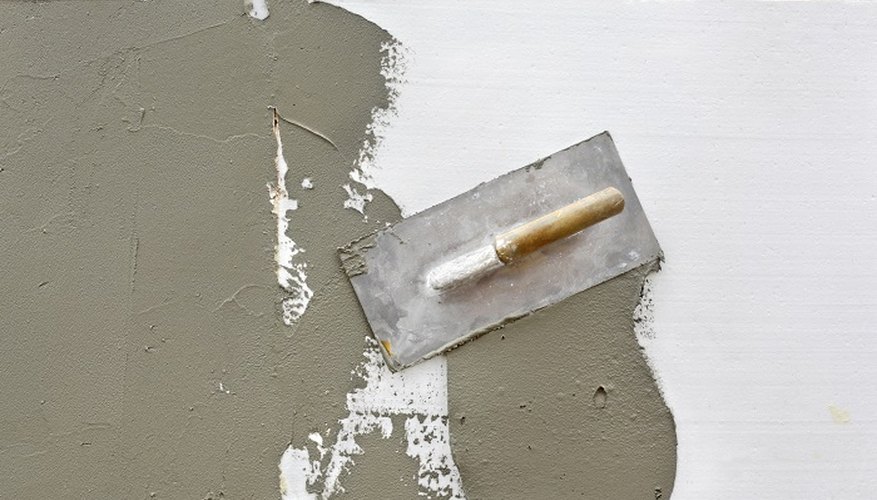Breeze blocks derive their name from the main component, breeze, the cinder-like material produced when coal or coke is burned. They are larger than bricks and suitable for both load-bearing and partition walls. Breeze blocks have a rough finish, so they are often covered by plasterboard. Plasterboard is fragile, and successful attachment requires a flat surface. This is often provided by a framework of wooden battens to which the board is screwed. However, plasterboard can also be bonded directly to breeze blocks using a technique called "dot and dab."
- Breeze blocks derive their name from the main component, breeze, the cinder-like material produced when coal or coke is burned.
- Breeze blocks have a rough finish, so they are often covered by plasterboard.
Clean the wall to remove grease, dirt, dust and loose material. Combine, in a bucket, PVA glue with cold water. Dilute the glue according to the manufacturer's instructions -- often a ratio of five parts of water to one part glue. Mix well and paint the mixture on to the area of breeze blocks. Work the mix well into the surface to seal it. Allow the glue to dry.
Add water to a builder's bucket, following the recommendations on the plasterboard adhesive packet. Add about two-thirds of the recommended quantity of adhesive powder to the water, stirring all the time to produce a creamy texture free of lumps and powder. Gradually add the remaining powder until the mix is thick enough to retain the mark when a trowel is pushed into it and used to cut the surface.
Use a plasterer's trowel to load a hawk -- a rectangular trowel used for holding plaster -- and apply a continuous line of adhesive dabs along the top of the breeze-block wall. The line should be continuous to form an airtight seal once the plasterboard is in position. Be generous in the application and produce a line of adhesive roughly as thick as a tennis ball.
- Add water to a builder's bucket, following the recommendations on the plasterboard adhesive packet.
- Use a plasterer's trowel to load a hawk -- a rectangular trowel used for holding plaster -- and apply a continuous line of adhesive dabs along the top of the breeze-block wall.
Apply generous dabs of adhesive at 30 cm (1 foot) intervals across the area covered by the first sheet of plasterboard. The finished wall should have a grid of adhesive covering the width and height of a board.
Move the plasterboard into position. Push it firmly against the adhesive and move it slightly from side to side to settle it against all the dabs. Check the board with a spirit level to ensure that it is vertical. Make any minor adjustments to the position and continue to bond the remaining boards in the same way.
TIP
Gather all the tools and materials you need before you start.
Cover the floor and windows before applying PVA glue to the wall. Once dried, the glue is difficult to remove, particularly from textured glass.
Always add adhesive powder to water, not water to powder. Adding water to powder forms unwanted lumps in the mix.
WARNING
Wear personal protective equipment when handling plasterboard. Wear gloves and safety footwear at all times and wear a face mask and goggles when mixing adhesive and plaster power.
